E-commerce app encompasses online marketplaces, service delivery, and electronic transactions via mobile devices and computers.
ECommerce mobile apps have become vital for businesses seeking to thrive in a competitive market. These apps offer robust features, including search functions, product recommendations, reviews, shopping cart management, and secure payment gateways. Today, eCommerce’s success hinges on delivering exceptional user experiences and wide product choices, driving the transformation of traditional stores into online powerhouses. In this digital era, eCommerce mobile app development is essential for business survival and success.
What Is Ecommerce App Development?
Ecommerce App Development” refers to the process of creating mobile applications specifically tailored for online shopping and conducting business transactions. These apps are designed to provide a seamless and user-friendly experience for customers, enabling them to browse and purchase products or services, manage their accounts, and interact with businesses directly from their mobile devices.
These apps not only bring convenience but also offer personalized experiences through features like recommendations based on your browsing and buying history. Plus, they often include secure payment methods, ensuring your financial information remains protected during transactions.
How E-Commerce Apps are Changing the Way We Shop in 2023

Source:InsiderIntelligence
E-commerce (Ecommerce) is rapidly gaining significance in the online shopping sector, with substantial growth predicted. Insider Intelligence estimates that by 2024, Ecommerce sales will reach $534.18 billion, constituting 40.4% of all eCommerce sales. Today, smartphones sales dominate Ecommerce, accounting for 87.2% of total sales, while tablet sales is projected to decrease to $54.01 billion by 2026, reflecting a shift in consumer preferences and improved shopping experiences.
6 Easy Steps to develop an Ecommerce App in 2023
Flow for developing an eCommerce app:-
Step 1: Market Research & Idea Testing
Commence the process of eCommerce app development by undertaking a rigorous program of market research. This endeavor entails a comprehensive understanding of the prospective customer base, encompassing their preferences, inclinations, and prevailing pain points. In addition, it necessitates the identification of market trends and the discernment of potential voids within the eCommerce landscape. To fortify your venture’s foundation, it is imperative to subject your app concept to meticulous scrutiny. This shall involve soliciting feedback and opinions from potential end-users to substantiate the viability of your proposition.
Step 2: Define Goals and Unique Features
Clearly articulate your business objectives and aspirations concerning the eCommerce app. This necessitates an unambiguous definition of key performance indicators (KPIs) and goals to chart your trajectory. Furthermore, it is imperative to pinpoint what confers a distinctive character upon your app amidst the competitive milieu. Identify unique features that not only render your app conspicuous but also furnish genuine utility to your user demographic. These features should harmonize with your corporate objectives and resonate with the needs of your target audience.
Step 3: Design User-Friendly Interface
Dedicate significant resources to the creation of an intuitive and aesthetically pleasing user interface (UI). Prioritize the aspect of user experience (UX) by meticulously crafting a navigation system that is seamless, facilitating effortless product discovery, and implementing a checkout process that is characterized by its unobtrusive efficiency. Central to this phase is user testing, which enables a systematic refinement of your app’s design to achieve optimal levels of user-friendliness and functionality.
Step 4: Develop the App
In the context of the actual development of your eCommerce app, it is imperative to judiciously select a technology stack that is attuned to your app’s requisites and possesses the scalability required for long-term growth. Consider the strategic deployment of a Minimum Viable Product (MVP) as an initial foray. This MVP should encompass fundamental features, expediting market entry and the accumulation of invaluable real-world user data to inform subsequent enhancements.
Step 5: Testing and Refinement
Stringent testing is the cornerstone of a resilient and dependable eCommerce app. Conducive to this endeavor is an exhaustive testing regime designed to guarantee seamless functionality. This encompasses rigorous usability testing to ascertain navigational ease, stringent security testing to safeguard user data, and comprehensive performance testing to ensure smooth operation under diverse conditions. The continual solicitation of user feedback is instrumental in the iterative refinement process, enabling enhancements that optimize the user experience and rectify any encountered issues.
Step 6: Launch and Ongoing Maintenance
The culmination of your development efforts is the app’s public launch. Execute this stage meticulously, with careful consideration of strategic marketing and promotional initiatives to generate widespread awareness. Subsequent to the launch, a regime of ongoing maintenance becomes imperative to ensure the app’s enduring security, stability, and alignment with evolving user expectations. Regular updates, encompassing bug fixes and feature improvements, constitute standard practice. The diligent monitoring of user feedback and the adaptability to market vicissitudes are essential for the sustained prosperity of your eCommerce app in the dynamic and competitive landscape of the United States.
Best and Latest Tech Stack to develop E-Commerce App in 2023
Tech Stack Recommendations | Description |
| React Native + Node.js + MongoDB + AWS | – React Native for cross-platform mobile development.Node.js and MongoDB for a flexible backend.AWS for secure cloud hosting. |
| Flutter + Firebase + PostgreSQL + Google Cloud Platform | – Flutter for cross-platform development with a seamless UI.Firebase for scalable and secure backend support.PostgreSQL for efficient database management.Google Cloud Platform for flexible cloud hosting. |
Android eCommerce App Development | Recommended Tools and Technologies |
| Language | Java or Kotlin |
| Core | Android SDK, Android Jetpack |
| Analytics | Firebase, Amplitude, AppsFlyer, Facebook |
| Data | Realm, SQLite, Shared Preferences, Room |
iOS eCommerce App Development | Recommended Tools and Technologies |
| Language | Objective-C or Swift |
| Core | iOS SDK, Cocoa Touch/Multimedia |
| Analytics | Firebase, Amplitude, AppsFlyer, Facebook |
| Data | Realm, CoreData, UserDefaults, KeyChain, CryptoSwift |
See Also: The Role of UX/UI Design in Elevating web App Development in the USA
Different kinds of E-Commerce Apps
B2C (Business-to-Consumer):
These are perhaps the most common e-commerce websites where businesses sell products or services directly to individual consumers. Examples include Amazon, eBay, and Walmart.B2B (Business-to-Business):
B2B e-commerce platforms facilitate transactions between businesses. They often involve bulk purchases, contract negotiations, and specialized pricing. Alibaba is a notable example.C2C (Consumer-to-Consumer):
In C2C e-commerce, individual consumers sell products or services to other consumers through an online platform. Examples include eBay and Etsy.C2B (Consumer-to-Business):
C2B e-commerce reverses the traditional model. Here, individual consumers offer products or services to businesses. Influencer marketing and freelance platforms like Upwork fall into this category.D2C (Direct-to-Consumer):
D2C e-commerce brands bypass traditional retailers and sell their products directly to consumers through their own online stores. Brands like Warby Parker and Casper mattresses follow this model.Marketplace:
Marketplace e-commerce platforms bring together multiple sellers and buyers. Sellers create their profiles, list products, and manage sales, while buyers can browse and purchase from various sellers. Examples include Etsy and Airbnb.Dropshipping:
In this model, e-commerce businesses do not hold inventory. Instead, they source products from suppliers as customers place orders. The business acts as an intermediary between suppliers and customers.Subscription E-commerce:
These platforms offer subscription-based services, where customers subscribe to receive products or services regularly. Examples include Birchbox (beauty products) and Netflix (streaming).Social Commerce:
Social media platforms integrate shopping features, allowing users to discover and purchase products directly within the social app. Instagram Shopping and Facebook Marketplace are examples.Crowdfunding Platforms:
While not traditional e-commerce, crowdfunding sites like Kickstarter and Indiegogo allow individuals and businesses to raise funds for their projects by offering backers various rewards or products.
Top 5 must have Features for E-Commerce Apps
Simple Registration:
Streamlined and user-friendly registration process for quick onboarding of customers.AR/VR Size Guide:
Augmented Reality (AR) or Virtual Reality (VR) technology to help customers visualize product sizes and fit.Notification and Reminder System:
Sending notifications and reminders to users about promotions, cart items, and order updates.Checkout:
Streamlined and secure payment processing at the end of the shopping journey using Apple Pay or Card options.Ratings & Feedback:
Enabling customers to rate and provide feedback on products and services.
Discover More: Challenges Faced by Web App Developers in the USA and How to Overcome Them
How much does it cost for developing E-Commerce App?
The cost of developing an e-commerce app in the US can vary greatly depending on a number of factors, including the following:
The complexity of the app:
A simple app with basic functionality will be less expensive to develop than a complex app with a lot of features.The platform:
An app for a single platform (iOS or Android) will be less expensive to develop than an app that is compatible with both platforms.The development team:
The cost of development will vary depending on the experience and expertise of the development team.The location of the development team:
The cost of development will also vary depending on the location of the development team.
In general, you can expect to pay anywhere from $10,000 to $500,000 to develop an e-commerce app in the US. Here is a breakdown of the average cost of developing an e-commerce app for different levels of complexity:
Basic e-commerce app:
$10,000 – $50,000Mid-range e-commerce app:
$50,000 – $150,000Complex e-commerce app:
$150,000 – $500,000+
Summary
In eCommerce app development, we tackle complex challenges like brand consistency, seamless user experiences, and online transitions. Whether you need a custom or off-the-shelf solution, our skilled team is ready to create a tailored app that fits your business. GeekyAnts excels in software discovery, UI/UX design, tech stacks, and dedicated development teams, making us your eCommerce app partner. Reach out today to discuss your app needs.
In the booming eCommerce landscape, a well-designed app is crucial for accessibility and competitiveness. Our experience ensures tailored solutions for your audience and products. If you’re starting an eCommerce app project, share it with us for expert support.


















